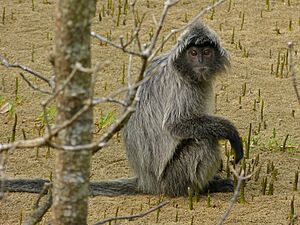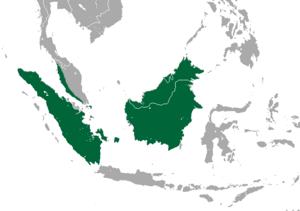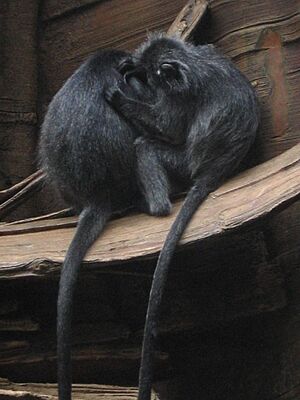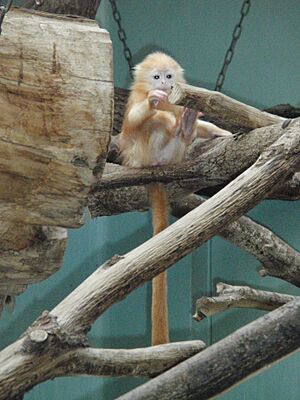Silvery lutung facts for kids
Quick facts for kids Silvery lutung |
|
|---|---|
 |
|
| Conservation status | |
| Scientific classification | |
| Genus: |
Trachypithecus
|
| Species: |
cristatus
|
 |
|
| Silvery lutung range | |
| Synonyms | |
|
Presbytis cristata |
|
The silvery lutung (Trachypithecus cristatus), also known as the silvered leaf monkey or the silvery langur, is a type of Old World monkey. These monkeys live in trees (they are arboreal) in forests near coasts, in mangrove swamps, and along rivers. You can find them in places like Peninsular Malaysia, Sumatra, Borneo, Java, and other nearby islands.
Contents
About the Silvery Lutung
The silvery lutung is a medium-sized monkey. It has a long tail that cannot grasp things (it's non-prehensile). Its fur is dark brown or black with grey tips, which makes it look silvery all over.
Unlike some other monkeys, it doesn't have lighter marks on its face or body. Females might have a small patch of whitish hair on their groin. A crest of fur runs along the top of its head, and the hair on its cheeks is long, sometimes covering its ears. Its hands and feet don't have hair and have dark skin. They also have thumbs and toes that can grip things.
Female lutungs are about 46 to 51 centimeters (18 to 20 inches) long from head to body. They weigh around 5.7 kilograms (12.6 pounds). Their tails are about 67 to 75 centimeters (26 to 30 inches) long. Males are a bit bigger, measuring 50 to 58 centimeters (20 to 23 inches) long. They weigh about 6.6 kilograms (14.6 pounds), and their tails are also 67 to 75 centimeters long.
Like other langurs, the silvery lutung has a special three-chambered stomach. This helps them digest cellulose, which is found in the leaves they eat. This process is like how ruminant animals (like cows) digest their food. Their intestine is also very long and has pouches. These pouches help break down plant material even more. Their teeth are also good for grinding tough leaves.
Where They Live
Silvery lutungs live across Borneo, Sumatra, and Java. They are also found in parts of the southwestern Malay Peninsula, the Natuna Islands, and other nearby islands. They prefer to live in mangrove swamps and forests close to coasts or rivers. They usually don't travel far from these water areas.
Monkey Family Tree
Scientists are still discussing how many types of silvery lutungs there are. In 2008, a study suggested there are two main types:
- Trachypithecus cristatus cristatus - found in Borneo, Sumatra, and the Natuna Islands.
- Trachypithecus cristatus selangorensis - found in the Malay Peninsula.
However, some scientists now think the Malay Peninsula type is a separate species called the Selangor silvered langur.
How They Evolved
Genetic studies show that silvery lutungs likely developed quickly about 0.95 to 1.25 million years ago. During this time, many species in their group, the T. cristatus species group, also appeared. Because this happened so fast, it can be hard to tell them apart genetically. The Javan lutung might be their closest living relative. Silvery lutungs have also been seen having babies with Phayre's leaf monkey, even though they are usually considered different groups.
Fossils of silvery lutungs have been found from the late Pleistocene period. These fossils show that they lived in the same areas as they do today. Some ancient lutungs had much larger cheek teeth than the ones alive now.
Hybrid Monkeys
In Sabah, Malaysia, scientists have seen silvery lutungs living in mixed groups with proboscis monkeys. They even saw them mating and found a possible hybrid baby. This baby was first seen near the Kinabatangan River in Malaysian Borneo. Researchers watched it grow and studied its photos. They concluded it was a very rare hybrid.
Hybrid animals are often unable to have babies themselves, especially when their parents are from very different groups. This is because their chromosomes don't match up well. However, a photo of the adult hybrid showed her holding and nursing a baby. Scientists think this might be happening because both monkey species are forced to live in small areas of riverine forest. This is due to deforestation for oil palm trees, which breaks up their homes. This has led to a separated population of both species.
Daily Life and Habits
Silvery lutungs are active during the day (they are diurnal). They live in groups of about 9 to 40 monkeys. Each group usually has one adult male and many adult females. The females often help each other care for the baby monkeys.
They rarely leave the trees, which keep them safe from predators on the ground. If they feel threatened, they quickly run away. Each group has a home area of about 20 to 43 hectares (50 to 106 acres). These areas can sometimes overlap with other groups. During the day, they might travel up to 500 meters (1,600 feet) through the forest. Sometimes, all the females might form smaller groups and separate from the male. The whole group sleeps together in one tree at night.
Silvery lutung groups are usually led by females (they are matrilineal). They also live in a harem system, meaning one male lives with many females. Females stay in their group for life. Males leave their birth group when they become adults. They then live in small groups with other males until they can take over their own harem. In a group, males are usually in charge of females. Females with babies are usually in charge of females without babies. However, there isn't much fighting within the group compared to some other monkey species.
Because different groups' home areas often overlap, they frequently meet each other. The adult male protects his group and territory from other males. He uses loud calls and sometimes fights to show he is dominant. If there are no males around, females from different groups are more likely to get along peacefully. The most serious fights happen when a male enters another male's territory. This can lead to the intruder taking over the group. In some other monkey groups, a new male might harm the young of the previous male. But with silvery lutungs, this is rarely seen and has not been directly observed.
Silvery lutungs are not as loud as some other related species. But they make at least thirteen different sounds. The most common sounds are made by adult males defending their territory. Other sounds show fear, anger, excitement, and happiness. Babies also make various calls.
What They Eat
The silvery lutung mainly eats leaves (it is a folivore). It eats more leaves than almost any other colobine monkey. While they do eat some fruit, seeds, and flowers, these make up only about 9% of their diet. They can also eat tougher and older leaves than their close relatives. Because of their diet, silvery lutungs usually don't live in the same parts of the forest as other monkeys. If other monkey species are in the same area, silvery lutungs are often found in the middle parts of the forest trees. This leaves the higher branches for monkeys that eat more fruit.
Reproduction and Life Cycle
Silvery lutungs can have babies all year round. There isn't a specific breeding season. A female usually gives birth about once every 18 to 24 months. The female attracts the male by moving her head from side to side. Mating can happen several times during one meeting. It's unusual, but females have been known to stop having babies (reach menopause) in the wild and can live up to nine years after their last birth.
The female gives birth to one baby after being pregnant for 181 to 200 days. Newborns weigh about 400 grams (14 ounces) and are about 20 centimeters (8 inches) long. They are born well-developed and can hold on tightly to their mother. Silvery lutungs are born with bright orange fur and white, hairless skin on their face, hands, and feet. Their skin quickly turns dark like an adult's. But their fur doesn't get its adult color until they are three to five months old. Females in the group help care for the young. Babies are not weaned (stop drinking milk) until they are 18 months old, even though the mother stops producing milk after 12 months. Young lutungs can have their own babies almost as soon as they are weaned. On average, females have their first baby at about 35 months old.
Silvery lutungs have lived up to 31 years in zoos.
Who Eats Them
Animals that hunt silvery lutungs include leopards, tigers, dholes (wild dogs), and some large snakes. Smaller meat-eating animals like binturongs probably hunt baby lutungs.
Diseases
Silvery lutungs can easily get human diseases, including AIDS. Because of this, they have been used a lot in medical research.
Protecting Silvery Lutungs
The silvery lutung is listed as a Vulnerable animal by the IUCN Red List. This means they are at high risk of becoming extinct. They are also listed in Appendix II of CITES, which controls trade in endangered species. Their homes are greatly threatened by logging (cutting down trees) and the growth of oil palm plantations. They are also hunted for their meat and captured to be sold as pets.
Images for kids








